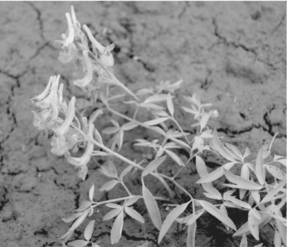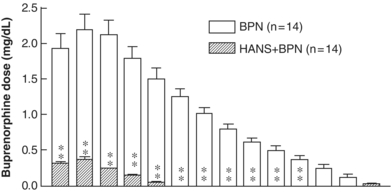David Y-W Lee, PhD
29
In view of the complexity of drug dependence and a limited number of effective treatments, it is conceivable that certain selected alternative pharmacotherapies may have important clinical significance. This chapter reviews traditional herbal medicines and therapies for the prevention of drug and alcohol abuse.
HERBAL REMEDIES WITH ANTIADDICTIVE POTENTIALS
The Chinese remedies developed during the Opium Wars era were combinations of more than a dozen herbs; thus, a mixture of herbs may well represent a multitargeted approach acting on opioid receptors that would have the benefits of improved overall efficacy with reduced toxicity. Few original remedies have been investigated scientifically. YGT (NPI-025) consists of five herbs (qiang huo, gou teng, chuan xiong, fu zi, and yanhusuo) most frequently used for substance abuse treatment in China. Yang et al. observed YGT effects among 300 individuals with “drug” addiction over a 10-year period and reported that NPI-025 significantly was associated with reduced withdrawal symptoms (−48%) compared to addicted individuals without treatment. Follow-up visits of many “cured” patients 1 to 3 years after treatment suggested that the use of NPI-025 may have been associated with overcoming craving for drugs.
Corydalis yanhusuo (Fig. 29-1) is one of the five Chinese medicinal plants in NPI-025. Chemical fractionation resulted in the isolation and characterization of l-tetrahydropalmatine (l-THP; Fig. 29-2) as one of the bioactive components. Two types of dopamine receptors, D1 class and D2 class, mediate dopamine neurotransmission. The D1 class includes both D1 and D5 receptors, while the D2 class includes D2, D3, and D4 receptors. There is a high-density distribution of D1 and D2 receptors in the striatum, which is relevant to the pharmacology of cocaine. Recent preclinical studies suggest that drugs that are selective for D1 or D2 receptors may reduce some aspects of cocaine self-stimulation or ethanol self-administration.

FIGURE 29-1. Corydalis yanhusuo.

FIGURE 29-2. Structure of dopamine, l-isocorypalmine, and l-tetrahydropalmatine (THP).
In summary, l-THP and l-isocorypalmine, a demethylated metabolite of l-THP, are two interesting compounds isolated from Corydalis yanhusuo. In vitro binding study showed that both l-THP and l-isocorypalmine have affinity toward D1, D2, and D5 receptors. In the functional assay, l-isocorypalmine is more potent than l-THP as D1 and D5 partial agonists and D2 antagonist. It is interesting to note that the skeleton of both l-THP and isocorypalmine resembles the dopamine molecule (see Fig. 29-2) with different numbers of methoxy group attached. These bioactive compounds derived from fractionation and in vitro screening may provide a better understanding of the mechanism of action of NPI-025 as a whole.
Uncaria rhynchophylla (Fig. 29-3) is an important traditional Chinese medicine used in the treatment of pain, infantile convulsions, headaches, dizziness, hypertension, and rheumatoid arthritis. Uncaria rhynchophylla is another ingredient in NPI-025. In order to clarify the mechanism of action, 12 compounds have been isolated. Among them, two major alkaloids, rhynchophylline and isorhynchophylline (Fig. 29-4), have been identified as the antiaddictive components with moderate binding activity for dopamine receptors [3H]DIP rMOR and [3H]DIP mDOR.

FIGURE 29-3. Uncaria rhynchophylla.

FIGURE 29-4. Structures of rhynchophylline and isorhynchophylline.
Pueraria lobata (kudzu extract) has been used historically to treat alcohol-related problems. Keung and Vallee showed that daidzin reduced consumption by 50% in Syrian golden hamsters. Puerarin was effective in two studies: Lin et al. showed a 40% reduction of intake in female alcohol-preferring rats given 100 mg/kg/day for 7 days mixed in food and a 65% reduction at 300 mg/kg/day. In the same study, daidzin and daidzein 100 mg/kg/day reduced consumption to 75% and 50%. Benlhabib et al. showed a 50% suppression of intake in rats by puerarin 50 mg/kg. In humans, Lukas et al. studied the effects of a kudzu root extract that contained 25% isoflavones (20% puerarin, 4% daidzin, 1.35% daidzein) in heavy drinkers and showed a significant reduction in beer consumption in addition to several significant changes in drinking topography, including an increase in the number of sips taken to finish a beer and an increase in the latency to opening subsequent beers. In a second study, where the same extract was administered for 4 weeks in an outpatient setting, Penetar et al. found a significant reduction in intake during weeks 2 through 4. Building on these encouraging results, we repeated the in-laboratory afternoon drinking session paradigm with the single isoflavone puerarin and found that participants consumed on average 3.5 (±0.6) beers after placebo and 2.4 (±0.4) after puerarin. None of the puerarin subjects drank 5 or 6 beers, while 3 placebo subjects drank 5, and 1 drank all 6. These studies demonstrate that puerarin can reduce alcohol drinking in humans. However, the mechanism of action of puerarin remains to be elucidated, and the implications outside of laboratory settings remain to be confirmed.
TRANSCUTANEOUS ELECTRICAL ACUPOINT STIMULATION (TEAS) AS A NONINVASIVE ALTERNATIVE THERAPY FOR ALCOHOL AND DRUG ABUSE
In animal experiments, manual acupuncture or acupuncture combined with electrical stimulation (electroacupuncture, or EA) was shown to accelerate the production and release of endorphins that can interact with different kinds of opioid receptors to ease pain. Interestingly, electrical stimulation of different frequencies can induce the release of different kinds of endorphins. For example, low-frequency (2 to 4 Hz) EA accelerates the release of enkephalins to interact with μ- and δ-receptors, whereas high-frequency (100 Hz) EA accelerates the release of dynorphin to interact with κ-receptors. These findings strengthen the scientific basis of this ancient healing art and point the way to its use in areas beyond pain control. Satisfactory results were obtained using this transcutaneous electrical acupoint stimulation (TEAS) for the treatment of heroin withdrawal syndrome in humans.
OPIOID DETOXIFICATION WITH TRANSCUTANEOUS ELECTRICAL ACUPOINT STIMULATION
In clinical practice, opioid withdrawal symptoms could be reduced but not abolished by the TEAS treatment, especially in those cases with a history of heroin abuse for more than 5 years. TEAS was applied on the acupoints Hegu/Laogong, Neiguan/Waiguan, and Xingjian/Sanyinjiao). Buprenorphine (BPN, IM) was used as a supplement to TEAS when the patient experienced a specified degree of withdrawal distress and was given immediately upon request. The purpose of this arrangement was to maintain a comfortable detoxification procedure without any withdrawal syndrome. As shown in Figure 29-5, the group receiving TEAS required only 8% of the BPN required by the group not receiving TEAS. This can be taken as a quantitative estimate of the effect of TEAS for opioid detoxification. A similar reduction occurred in another group of heroin-dependent individuals with a methadone reduction protocol for the control group and “a TEAS (2/100 Hz) plus methadone” experimental group with a reduction of 75% methadone use for the TEAS + methadone group.

FIGURE 29-5. Influence of 2/100 Hz electric stimulation (HANS) on the requirement of BPN for heroin detoxification. **p < 0.01 compared with the corresponding control group. (Reprinted from Han JS, Trachtenberg AI, Lowinson JH. Acupuncture. In: Lowinson JH, et al., eds. Substance abuse: A comprehensive textbook. Philadelphia, PA: Lippincott Williams & Wilkins; 2004:743–782.)
Stay updated, free articles. Join our Telegram channel

Full access? Get Clinical Tree


